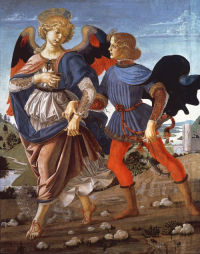The Natural World Click on the thumbnails to explore the trail
Read more about this trail (expand)
Leonardo’s endless curiosity regarding the form and function of all natural phenomena is attested to in his drawings, manuscripts and paintings. As nature could only be understood by direct “experience” or engagement with real life models, man, plants, animals, and the world that they inhabited became the subject of intense scrutiny in the quest for understanding of all natural things.

- Enlarge
- © National Gallery, London
Tobias and the Angel c1473
In Leonardo’s opinion, it was not sufficient for the artist to represent the appearance of things. He should also convey how they moved and functioned as living beings.
Both the dog and the fish in Tobias and the Angel are thought to be the work of the young Leonardo, and as such are evidence of his approach to painting. The dog’s coat has been rendered with great painterly freedom. The fluffy texture of the coat and the dog’s jaunty pose convey a wonderful sense of movement and vitality. The raised forelock and the turn of its head mimics the pose of the Archangel Raphael perfectly. Both appear to stride forward in unison.
The iridescent quality of the fish’s scales and their reflective quality are wonderfully captured. The wriggling body and open-mouth of the fish seem to indicate the life that has barely departed from its body. In a novel concern for naturalistic, narrative detail, Leonardo has also taken care to portray it as bloody to indicate that Tobias has already removed the gall to use as a remedy for restoring his father’s sight.
In Leonardo's words
If you scorn painting, which is the sole imitator of all the manifest works of nature, you will certainly be scorning a subtle invention, which with philosophical and subtle speculation considers all manner of forms; sea, land, trees, animals, grasses, flowers…truly this is a science, the legitimate daughter of nature…
This small panel is typical of the type of painted works produced in the workshop of Andrea del Verrocchio in Florence during the 1470s, which clearly exhibits the work of different artists.
The painting is sometimes attributed to Perugino, who was said to have worked in Verrocchio’s workshop and parts such as the dog and the fish are thought to have been painted by Leonardo.
- Medium Tempera on wood panel
- Size 83.6 x 66 cm
- Location National Gallery










